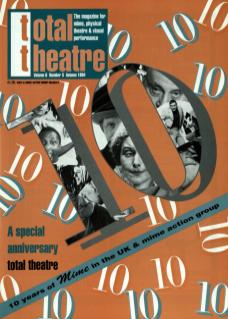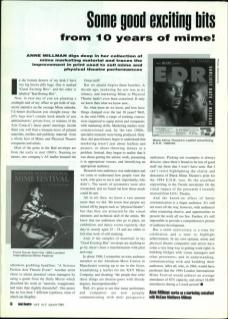In the bottom drawer of my desk I have two big brown jiffy bags. One is marked ‘Good Exciting Bits’, and the other is labelled ‘Bad Boring Bits’. Now, in case any of you are planning a midnight raid of my office to get hold of top-secret statistics on the average Mime attender, I'd better disillusion you straight away: the jiffy bags don't contain lurid details of arts administrators' private lives, or minutes of the Arts Council's latest panel meetings. Inside them you will find a treasure trove of printed materials, leaflets and publicity material from a whole host of Mime and Physical Theatre companies and artists.
Most of the gems in the Bad envelope are from the early to mid 1980s. Naming no names, one company's A5 leaflet boasted the attention-grabbing headline: ‘A Science Fiction Arts Theatre Event’. Another artist chose to attract potential venue managers by using a quote from the Daily Mirror which described his work as ‘neurotic, exaggerated, and more than slightly distasteful’. One poster has no less than seven different typefaces, most of which are illegible.
Great stuff!
But we should forgive these howlers. A decade ago, marketing the arts was in its infancy, and marketing Mime or Physical Theatre hadn't even been conceived. If only we knew then what we know now...
So, what more do we know, and how have things changed over the last ten years? Well, in the mid 1980s a range of training courses were organised to equip artists and companies with marketing skills. Marketing studies were commissioned and, by the late 1980s, specialist manuals were being produced. Only then did practitioners begin to understand that marketing wasn't just about leaflets and posters, or about throwing money at a problem. Instead, they began to realise that it was about getting the artistic work, presenting it in appropriate venues, and identifying an appropriate audience.
Research into audiences was undertaken and we came to understand how people view the work, who goes to see it and, importantly, who didn't. The needs of promoters were also researched, and we found out how those needs could be met.
All in all, then, we know a vast amount more than we did. We know that people are turned off by jargon such as ‘physical theatre’ but that they are attracted by the visual elements and technical skill of the artists. We know that our audiences also go to plays, art exhibitions and dance events regularly, that they're mostly aged 25-34, and are either in full-time work of still studying.
And, if the samples of materials in my ‘Good Exciting Bits’ envelope are anything to go by, there's been a transformation with print and copy.
In about 1986, I remember an irate audience member at the Abraham Moss Centre in Manchester coming up to me in the foyer, brandishing a leaflet for the XXY Mime Company, and shouting: ‘the people that write these things are theatre-goers with bloody degrees. Incomprehensible.’
Well, it's great to see that many performers and companies are now actually communicating with their prospective audiences. Picking out examples is always divisive, since there's bound to be lots of good stuff out there that I won't have seen. But I can't resist highlighting the clarity and directness of Black Mime Theatre's print for the 1994 EDR tour. Or the excellent copywriting in the Trestle newsletter. Or the visual impact of the postcards I recently received from IOU Theatre.
And the knock-on effect of better communication is a larger audience. It's still not roses all the way, however, with audiences often remaining elusive, and opportunities to present the work all too few. Further, it's still impossible to provide a comprehensive picture of audience development.
But a tenth anniversary is a time for celebration and a time to highlight achievements. In my own opinion, mime and physical theatre companies and artists have come a very long way in getting work right in building bridges with venue managers and other presenters – and in understanding, communicating with and building their audiences. After all, who, in 1984, would have predicted that the 1994 London International Mime Festival would achieve an average attendance of 82% capacity, and attract 18,000 attendances during a two-week period!
Anne Millman works as a marketing consultant with McCann Matthews Millman.

